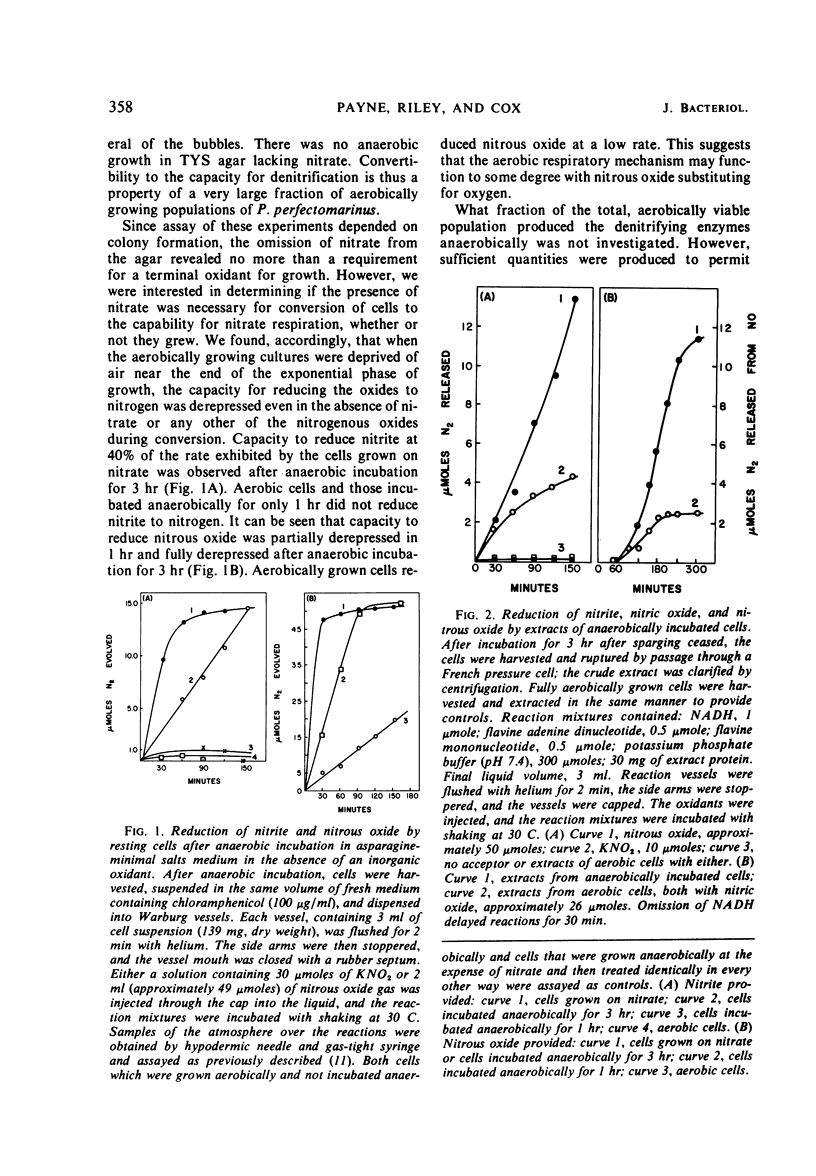Abstract
Pseudomonas perfectomarinus was found to grow anaerobically at the expense of nitrate, nitrite, or nitrous oxide but not chlorate or nitric oxide. In several repetitive experiments, anaerobic incubation in culture media containing nitrate revealed that an average of 82% of the cells in aerobically grown populations were converted to the capacity for respiration of nitrate. Although they did not form colonies under these conditions, the bacteria synthesized the denitrifying enzymes within 3 hr in the absence of oxygen or another acceptable inorganic oxidant. This was demonstrated by the ability, after anaerobic incubation, of cells and of extracts to reduce nitrite, nitric oxide, and nitrous oxide to nitrogen. From crude extracts of cells grown on nitrate, nitrite, or nitrous oxide, separate complex fractions were obtained that utilized reduced nicotinamide adenine dinucleotide as the source of electrons for the reduction of (i) nitrite to nitric oxide, (ii) nitric oxide to nitrous oxide, and (iii) nitrous oxide to nitrogen. Gas chromatographic analyses revealed that each of these fractions reduced only one of the nitrogenous oxides.
Full text
PDF





Selected References
These references are in PubMed. This may not be the complete list of references from this article.
- ALLEN M. B., VAN NIEL C. B. Experiments on bacterial denitrification. J Bacteriol. 1952 Sep;64(3):397–412. doi: 10.1128/jb.64.3.397-412.1952. [DOI] [PMC free article] [PubMed] [Google Scholar]
- BEST A. N., PAYNE W. J. PRELIMINARY ENZYMATIC EVENTS IN ASPARAGINE-DEPENDENT DENITRIFICATION BY PSEUDOMONAS PERFECTOMARINUS. J Bacteriol. 1965 Apr;89:1051–1054. doi: 10.1128/jb.89.4.1051-1054.1965. [DOI] [PMC free article] [PubMed] [Google Scholar]
- DELWICHE C. C. Production and utilization of nitrous oxide by Pseudomonas denitrificans. J Bacteriol. 1959 Jan;77(1):55–59. doi: 10.1128/jb.77.1.55-59.1959. [DOI] [PMC free article] [PubMed] [Google Scholar]
- Lam Y., Nicholas D. J. A nitrite reductase with cytochrome oxidase activity from Micrococcus denitrificans. Biochim Biophys Acta. 1969 Aug 5;180(3):459–472. doi: 10.1016/0005-2728(69)90025-5. [DOI] [PubMed] [Google Scholar]
- Matsubara T., Mori T. Studies on denitrification. IX. Nitrous oxide, its production and reduction to nitrogen. J Biochem. 1968 Dec;64(6):863–871. doi: 10.1093/oxfordjournals.jbchem.a128968. [DOI] [PubMed] [Google Scholar]
- Newton N. The two-haem nitrite reductase of Micrococcus denitrificans. Biochim Biophys Acta. 1969;185(2):316–331. doi: 10.1016/0005-2744(69)90425-2. [DOI] [PubMed] [Google Scholar]
- Payne W. J., Riley P. S. Suppression by nitrate of enzymatic reduction of nitric oxide. Proc Soc Exp Biol Med. 1969 Oct;132(1):258–260. doi: 10.3181/00379727-132-34192. [DOI] [PubMed] [Google Scholar]
- Pichinoty F., Piéchaud M. Recherche des nitrate-réductases bactériennes A et B: méthodes. Ann Inst Pasteur (Paris) 1968 Jan;114(1):77–98. [PubMed] [Google Scholar]
- Radcliffe B. C., Nicholas D. J. Some properties of a nitrite reductase from Pseudomonas denitrificans. Biochim Biophys Acta. 1968 Apr 2;153(3):545–554. doi: 10.1016/0005-2728(68)90184-9. [DOI] [PubMed] [Google Scholar]
- Renner E. D., Becker G. E. Production of nitric oxide and nitrous oxide during denitrification by Corynebacterium nephridii. J Bacteriol. 1970 Mar;101(3):821–826. doi: 10.1128/jb.101.3.821-826.1970. [DOI] [PMC free article] [PubMed] [Google Scholar]
- WALKER G. C., NICHOLAS D. J. Nitrite reductase from Pseudomonas aeruginosa. Biochim Biophys Acta. 1961 May 13;49:350–360. doi: 10.1016/0006-3002(61)90134-2. [DOI] [PubMed] [Google Scholar]
- YAMANAKA T. IDENTITY OF PSEUDOMONAS CYTOCHROME OXIDASE WITH PSEUDOMONAS NITRITE REDUCTASE. Nature. 1964 Oct 17;204:253–255. doi: 10.1038/204253a0. [DOI] [PubMed] [Google Scholar]


